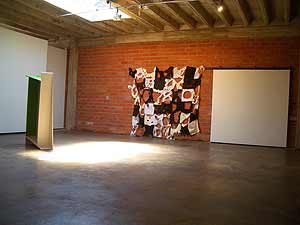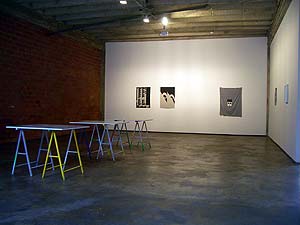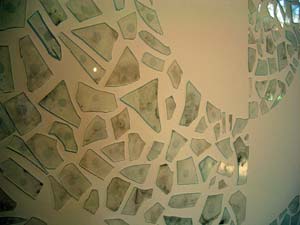Invective exists sporadically in the doldrums of art criticism, and curator Tom Humphreys seems to be soliciting such treatment with the current display at Triangle Project Space. The tepid premise of the show percolates on the concept of Virginia Woolf’s book of essays The Common Reader, and fails to bring anything to a boil.
Overall, the works are completely disjointed and ill-executed. Crafty intentions do not insure exceptional art. From the germinal collages of AIDS brochures and glossy advertisements to the middle-of-the-road, broken glass crop circle/mosaic, there’s little to hold your attention. Flatulent pieces of jar-shaped cardboard lean against walls like sluggardly props from an unsuccessful folk art market. The opening reception itself was a dullard affair, complete with some sort of keg that squirted out a dubious liquid devoid of bubbles.
It is unfortunate that Humphreys produced such a regression for one of the largest contemporary art spaces in San Antonio. With a grand re-opening just this past November at the new location, TPS seems a bit like an inchoate pop phenomnan stumbling into its eagerly anticipated sophomore show/space.
Humphreys has brought in some international artists for this show. The German collaborators from Frankfurt’s Stadelschule include Lucie Stahl, Alexander Wolff and Will Benedict. Between the crocheted yarn curtain sans raconteur and the circular glass mosaic added to a moveable white wall of doom, Wolff breeds corporate and corporal aesthetics without an audience in mind. Is it the process? Could the general concept of craft really dwell in a subterranean mecca of brittle bottles and unwieldy knitting needles? Maybe.
The space itself seems hollowed and threadbare despite the generally large-scale pieces interspersed with average-proportioned paintings and nifty display cases. Upon first glance, the show seems thin and lacks the sharp curatorial eye to carve into high concepts and produce a show that illuminates its artists” abilities rather than drowns them in an incongruent stew. The mismatched works displayed in The Common Reader could be vaguely interesting standing apart, but in this collaboration they lose their charge. Without titles adjacent to the appropriate structures, these flimsy sculptures, black and white paintings and ornamental crafts just sit dull and inert in the vacuous rooms.
If the show is inspired by a Virginia Woolf collection of essays on writing, then it is appropriate to look to her for a sui generis insight into the contents of this show. Her essay “How It Strikes a Contemporary” from The Common Reader, published in 1925, looked into criticism itself and its intentions and contentions with early masterpieces of the 19th century. She dismissed most modern fiction as thin and void of substance or true sincerity, saying books cranked out by her contemporaries were produced under pressure by hasty, indiscriminant hands: “Book after book leaves us with the same sense of promise unachieved, of intellectual poverty, of brilliance which has been snatched from life but not transmuted into literature.” If we substitute books for a painting or sculpture and art for literature, this same observation could be applied to the exhibition at TPS.
Perhaps the intentions of the curator could have been fleshed out with a greater consideration for the unique railroad warehouse space offered by TPS. This could merely be a matter of logistics. Still, importing artists from Germany and giving them such a wonderful space to work in appears terra firma, particularly when you consider TPS’s track record. Humphreys really did a disservice to the artists and the community with this weak effort to display disjointed artwork beneath the canopy of such a significant literary opus.
The exhibition The Common Reader sinks under the weight of its grand intent. Still, this collaboration isn’t completely incongruent with Woolf’s writings. In the aforementioned essay, she wrote about “the anonymous activities of free craftsmen working under the lash of no master, but obscurely, with ardor…” The state of contemporary art in San Antonio thrives upon innovation and experimentation, particularly when it encompasses unconventional spaces. Triangle Project Space may have missed the mark with this show, but the gallery’s potential and verisimilitude persists.
And Woolf says it best when she chimes, “Critics, of course, abound.”
Images courtesty Triangle Project Space.
Michelle Gonzalez Valdez is an artist and writer living in San Antonio. She is also the contributing editor of …might be good.






